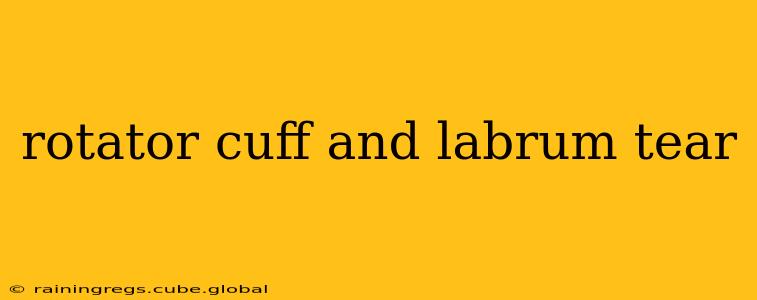Shoulder pain is a common complaint, often stemming from injuries to the rotator cuff and labrum. These structures are crucial for shoulder stability and movement, and damage to either can significantly impact daily activities. This comprehensive guide will delve into the intricacies of rotator cuff and labrum tears, explaining their causes, symptoms, diagnosis, and treatment options.
What is a Rotator Cuff Tear?
The rotator cuff is a group of four muscles and their tendons that surround the shoulder joint. These muscles—supraspinatus, infraspinatus, teres minor, and subscapularis—work together to stabilize the shoulder, allowing for a wide range of motion. A rotator cuff tear occurs when one or more of these tendons are torn, often due to overuse, injury, or age-related degeneration. Tears can range from small, partial tears to large, complete tears that sever the tendon.
What causes a rotator cuff tear?
- Sudden injury: A fall, direct blow to the shoulder, or a sudden, forceful movement can cause a rotator cuff tear. Athletes involved in sports like baseball, tennis, or weightlifting are particularly vulnerable.
- Overuse: Repetitive overhead movements, especially without proper warm-up and conditioning, can gradually wear down the rotator cuff tendons, leading to tears. This is common in manual laborers and athletes.
- Age-related degeneration: As we age, the tendons of the rotator cuff can become weaker and more prone to tearing. Degenerative changes can occur even without significant trauma.
- Poor posture: Maintaining poor posture can strain the rotator cuff, increasing the risk of injury.
What is a Labrum Tear?
The labrum is a ring of cartilage that surrounds the shoulder socket (glenoid), providing stability and depth to the joint. A labrum tear is a disruption of this cartilage, often occurring due to a sudden impact or repetitive stress. There are several types of labrum tears, including SLAP (Superior Labrum Anterior to Posterior) tears, which affect the upper part of the labrum.
What causes a labrum tear?
- Sudden impact: Falls, direct blows to the shoulder, or forceful twisting movements can cause labrum tears.
- Repetitive overhead activities: Similar to rotator cuff tears, repeated overhead movements can lead to labrum damage over time.
- Instability: Shoulder instability, where the shoulder joint dislocates or subluxes, can also contribute to labrum tears. This is often seen in individuals with hyperlaxity (increased joint flexibility).
Can you have both a rotator cuff and labrum tear simultaneously?
Yes, it's possible, and even relatively common, to have both a rotator cuff tear and a labrum tear at the same time. The shoulder joint is complex, and injuries often affect multiple structures. The mechanisms of injury that cause one can often affect the other. For example, a fall directly onto the shoulder might tear the rotator cuff and also damage the labrum.
What are the symptoms of a rotator cuff and labrum tear?
Symptoms can vary depending on the severity and location of the tear. Common symptoms include:
- Shoulder pain: Pain can range from mild to severe and may worsen with movement or at night.
- Weakness: Difficulty lifting or rotating the arm.
- Limited range of motion: Inability to fully raise or rotate the arm.
- Clicking or popping: A sensation of the shoulder clicking or popping during movement.
- Instability: Feeling like the shoulder is unstable or may dislocate.
How are rotator cuff and labrum tears diagnosed?
Diagnosis typically involves a physical examination and imaging studies. The physician will assess range of motion, strength, and tenderness. Imaging tests may include:
- X-rays: To rule out fractures or other bone abnormalities.
- MRI: To visualize the soft tissues of the shoulder, including the rotator cuff and labrum.
- Arthrogram: A special type of MRI or X-ray that involves injecting contrast dye into the shoulder joint to better visualize the labrum.
What are the treatment options for rotator cuff and labrum tears?
Treatment options depend on the severity of the tear and the individual's symptoms. Options include:
- Conservative treatment: This may include rest, ice, medication (pain relievers and anti-inflammatories), physical therapy, and activity modification.
- Surgery: In cases of significant tears or persistent pain despite conservative treatment, surgery may be necessary. Arthroscopic surgery is a minimally invasive procedure often used to repair rotator cuff and labrum tears.
How long does it take to recover from a rotator cuff and labrum tear?
Recovery time varies depending on the severity of the injury, the type of treatment received, and the individual's overall health. Conservative treatment may take several weeks or months for full recovery. Surgical repair typically requires a longer recovery period, potentially lasting several months or even longer. Physical therapy plays a vital role in regaining strength and range of motion after both conservative and surgical treatment. It is critical to follow your physician's and physical therapist's instructions meticulously.
This information is for general knowledge and does not constitute medical advice. Always consult with a healthcare professional for diagnosis and treatment of any medical condition.
